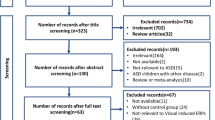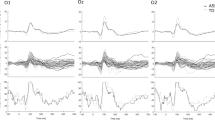Abstract
Event-related brain potentials (ERPs) elicited by visual and auditory stimuli were recorded from nonretarded individuals with autism (ages 13–25 years) and age-matched normal controls. In “no-task” conditions, subjects simply looked at or listened to these stimuli; only one difference was found between subject groups. Several ERP differences between groups were found in “task” conditions; subjects pressed a button at the occurrence of target stimuli intermixed with unexpected, novel stimuli and also with expected, nonnovel stimuli. Visual ERP abnormalities in the autistic group differed from auditory abnormalities. Results suggest that (1) nonretarded autistic individuals may have a limited capacity to process novel information — they are neither hypersensitive to novel information nor misperceive it as non-novel and insignificant; (2) classification of simple visual information may be less impaired than auditory; and (3) with one exception, visual and auditory ERP abnormalities do not seem to reflect maturational delay.
Similar content being viewed by others
References
Caparulo, B. K., Cohen, D. J., Rothman, S. L., Young, J. G., Katz, J. D., Shaywitz, S. E., & Shaywitz, B. A. (1981). Computed tomographic brain scanning in children with developmental neuropsychiatric disorders.Journal of the American Academy of Child Psychiatry, 20, 338–357.
Courchesne, E. (1977). Event-related brain potentials: A comparison between children and adults.Science, 197, 589–592.
Courchesne, E. (1978). Neurophysiological correlates of cognitive development: Changes in long-latency event-related potentials from childhood to adulthood.Electroencephalography and Clnicial Neurophysiology, 45, 468–482.
Courchesne, E. (1983). Cognitive components of the event-related brain potential: Changes associated with development. In A. W. K. Gaillard & W. Ritter (Eds.),Tutorials in ERP research: Endogenous components (pp. 329–344). Amsterdam: North-Holland.
Courchesne, E. & Galambos, R. From childhood to adulthood: Changes in cognitive components of the auditory event-related brain potential. In preparation.
Courchesne, E., Ganz L., & Norcia, A. N. (1981). Event-related brain potentials to human faces in infants.Child Development, 52, 804–811.
Courchesne, E., Kilman, B. A., Galambos, R., & Lincoln, A. J. (1984). Autism: Cognitive processing of novel information measured by event-related brain potentials.Electroencephalography and Clinical Neurophysiology, 59, 238–248.
Damasio, H., Maurer, R. G., Damasio, A. R., & Chui, H. C. (1980). Computerized tomographic scan findings in patients with autistic behavior.Archives of Neurology, 37, 504–510.
DeLong, G. R. (1978). A neuropsychological interpretation of infantile autism. In M. Rutter & E. Schopler (Eds.),Autism: A reappraisal of concepts and treatment (pp. 207–218). New York: Plenum Press.
DeMyer, M. K., Hingtgen, J. N., & Jackson, R. K. (1981). Infantile autism reviewed: A decade of research.Schizophrenia Bulletin, 7, 388–451.
Ford, J. M., Mohs, R. C., Pfefferbaum, A., & Kopell, B. S. (1980). On the utility of P3 latency and RT for studying cognitive processes. In H. H. Kornhuber & L. Deecke (Eds.),Motivation, motor and sensory processes of the brain: Progress in brain research (Vol. 54, pp. 661–667). Amsterdam: Elsevier/North-Holland Biomedical Press.
Ford, J. M., Roth, W. T., Mohs, R. C., Hopkins, W. F., & Kopell, B. S. (1979). Event-related potentials recorded from young and old adults during a memory retrieval task.Electroencephalography and Clinical Neurophysiology, 47, 450–459.
Friedman, D., Brown, C., Sutton, S., & Putnam, L. (1982). Cognitive potentials in a picturematching task: Comparison of children and adults. In A. Rothenberger (Ed.),Eventrelated potentials in chldren (pp. 325–336). Amsterdam: Elsevier Biomedical Press.
Friedman, D., Vaughan, H. G., Jr., & Erlenmeyer-Kimling, L. (1981). Multiple late positive potentials in two visual discrimination tasks.Psychophysiology, 18, 635–649.
Gillberg, C., Rosenhall, U., & Johansson, E. (1983). Auditory brainstem responses in childhood psychosis.Journal of Autism and Developmental Disorders, 13, 181–195.
Gold, M. S., & Gold, J. R. (1975). Autism and attention: Theoretical considerations and a pilot study using set reaction time.Child Psychiatry and Human Development, 6, 68–80.
Groves, P. M., & Lynch, G. S. (1972). Mechanisms of habituation in the brain stem.Psychological Review, 79, 237–244.
Halgren, E., Squires, N. K., Wilson, C. L., Rohrbaugh, J. W., Babb, T. L., & Crandall, P. H. (1980). Endogenous potentials generated in the human hippocampal-formation and amygdala by infrequent events.Science, 210, 803–805.
Hansen, J. C., & Hillyard, S. A. (1980). Endogenous brain potentials associated with selective auditory attention.Electroencephalography and Clinical Neurophysiology, 49, 277–290.
Hauser, S. L., DeLong, G. R., & Rosman, N. P. (1975). Pneumographic findings in the infantile autism syndrome.Brain, 98, 667–688.
Hermelin, B. (1976). Coding and sense modalities. In L. Wing (Ed.),Early childhood autism: Clinical, educational and social aspects. Oxford: Pergamon Press.
Hier, D. B., LeMay, M., & Rosenberger, P. B. (1979). Autism and unfavorable left-right asymmetries of the brain.Journal of Autism and Developmental Disorders, 9, 153–159.
Hillyard, S. A., Hink, R. F., Schwent, V., & Picton, T. W. (1973). Electrical signs of selective attention in the human brain.Science, 182, 177–180.
Hillyard, S. A., & Picton, T. W. (1979). Event-related brain potentials and selective information processing in man. In J. E. Desmedt (Ed.),Progress in clinical neurophysiology (Vol. 6, pp. 1–52). Basel: S. Karger.
Hillyard, S. A., Picton, T. W., & Regan, D. (1978). Sensation, perception, and attention: Analysis using ERPs. In E. Callaway, P. Tueting, & S. H. Koslow (Eds.),Event-related brain potentials in man (pp. 223–321). San Francisco: Academic Press.
Hoffmann, W. L. & Prior, M. R. (1982). Neuropsychological dimensions of autism in children: A test of the hemispheric dysfunction hypothesis.Journal of Clinical Neuropsychology, 4, 27–41.
James, A. L., & Barry, R. J. (1980). Respiratory and vascular responses to simple visual stimuli in autistics, retardates and normals.Psychophysiology, 17, 541–547.
Knight, R. T. (1984). Decreased response to novel stimuli after prefrontal lesions in man.Electroencephalography and Clnical Neurophysiology, 59, 9–20.
Kootz, J. P., & Cohen, D. J. (1981). Modulation of sensory intake in autistic children.Journal of the Amreican Academy of Child Psychiatry, 20, 692–701.
Kurtzberg, D., Vaughan, H. G., Jr., & Kreuzer, J. (1979). Task-related cortical potentials in children: In J. E. Desmedt (Ed.),Cognitive components in cerebral event-related potentials and selective attention (pp. 216–223). Basel: S. Karger.
Kutas, M., McCarthy, G., & Donchin, E. (1977). Augmenting mental chronometry: The P300 as a measure of stimulus evaluation.Science, 197, 792–795.
Lockyer, L., & Rutter, M. (1970). A five to fifteen years follow-up study of infantile psychosis: IV. Patterns of cognitive ability.British Journal of Social and Clinical Psychology, 9, 152–163.
Luria, A. R. & Homskaya, E. D. (1970). Frontal lobes and the regulation of arousal process. In D. I. Mostofsky (Ed.),Attention: Contemporary theory and analysis (pp. 303–330). New York: Appleton-Century-Crofts.
Martineau, J., Garreau, B., Barthelemy, C., & Lelord, G. (1981). Evoked potentials (300) during sensory stimulation in autistic children. Paper presented at the Sixth International Conference on Event-Related Slow Potentials, Lake Forrest, Illinois.
Novick, B., Kurtzberg, A., & Vaughan, H. G., Jr. (1979). An electrophysiologic indication of defective information storage in childhood autism.Psychiatry Research, 1, 101–108.
Novick, B., Vaughan, H. G., Jr., Kurtzberg, D., & Simson, R. (1980). An electrophysiologic indication of auditory processing defects in autism.Psychiatry Research, 3, 107–114.
O'Keefe, J. (1976). Place units in the hippocampus of the freely moving rat.Experimental Neurology, 51, 78–109.
Pritchard, W. S. (1981). Psychophysiology of P300.Psychological Bulletin, 89, 506–540.
Ranck, J. B. (1973). Studies on single neurons in dorsal hippocampal formation and septum in unrestrained rats. I. Behavioral correlates and firing repertoires.Experimental Neurology, 4, 185–200.
Roth, W. T., Pfefferbaum, A., Horvath, T. B., Berger, P. A., & Kopell, B. S. (1980). P3 reduction in auditory evoked potentials of schizophrenics.Electroencephalography and Clinical Neurophysiology, 49, 497–505.
Ruchkin, D. S., Sutton, S., Kietzman, M. L., & Silver, K. (1980). Slow wave and P300 in signal detection.Electroencephalography and Clinical Neurophysiology, 50, 35–47.
Rutter, M. (1974). The development of infantile autism.Psychological Medicine, 4, 147–163.
Rutter, M. (1978). Language disorder and infantile autism. In M. Rutter and E. Schopler (Eds.),Autism: A reappraisal of concepts and treatment (pp. 84–104). New York: Plenum Press.
Rutter, M. (1979). Language, cognition, and autism. In R. Katzman (Ed.),Congenital and acquired cognitive disorders (pp. 247–264). New York: Raven Press.
Small, J. G., DeMyer, M. K., & Milstein, V. (1971). CNV responses of autistic and normal children.Journal of Autism and Childhood Schizophrenia, 1, 215–231.
Sokolov, Y. N. (1963).Perception and the conditioned reflex. Oxford: Pergamon Press.
Squires, N. K., Donchin, E., & Squires, K. C. (1977). Bisensory stimulation: Inferring decision-related processes from P300 component.Journal of Experimental Psychology and Human Perceptual Performance, 3, 299–315.
Tsai, L. Y., Jacoby, C. G., & Stewart, M. A. (1983). Morphological cerebral asymetrics in autistic children.Biological Psychiatry, 18, 317–327.
Tueting, P. (1978). Event-related potentials, cognitive events, and information processing. In D. A. Otto (Ed.),Multidisciplinary perspectives in event-related brain potential research (pp. 159–169). Washington, D.C.: U.S. Government Printing Office, EPA-600/9-77-043.
Vinogradova, O. S. (1970). Registration of information and the limbic system. In G. Horn & R. A. Hinde (Eds.),Short-term changes in neural activity and behavior (pp. 95–140). Cambridge: Cambridge University Press.
Williams, R. S., Hauser, S. L., Purpura, D. P., DeLong, R., & Swisher, C. N. (1980). Autism and mental retardation: Neuropathologic studies performed in four retarded persons with autistic behavior.Archives of Neurology, 37, 749–753.
Woods, D. L., Courchesne, E., Hillyard, S. A., & Galambos, R. (1980). Recovery cycles of event-related potentials in multiple decision tasks.Electroencephalography and Clinical Neurophysiology, 50, 335–347.
Author information
Authors and Affiliations
Additional information
This research was supported by NIMH grant 1-R01-MH36840 awarded to E. Courchesne, NINCDS grant 5-RO1-NS19855 awarded to E. Courchesne, an Easter Seals Research Grant awarded to E. Courchesne, NICHHD grant 5-R01-HD11154 awarded to R. Galambos, and Children's Hospital Research Center, San Diego. Valuable assistance has also been provided by San Diego Regional Center for the Developmentally Disabled. We thank Rachel Y. Courchesne for her helpful comments on this manuscript and Phyllis Galambos for her technical assistance.
Rights and permissions
About this article
Cite this article
Courchesne, E., Lincoln, A.J., Kilman, B.A. et al. Event-related brain potential correlates of the processing of novel visual and auditory information in autism. J Autism Dev Disord 15, 55–76 (1985). https://doi.org/10.1007/BF01837899
Issue Date:
DOI: https://doi.org/10.1007/BF01837899




